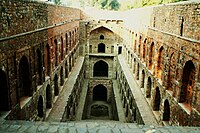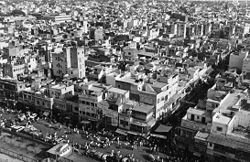
Back تاريخ دلهي Arabic দিল্লির ইতিহাস Bengali/Bangla Hen Ddelhi Welsh Histoire de Delhi French दिल्ली का इतिहास Hindi ದೆಹಲಿಯ ಇತಿಹಾಸ Kannada ഡെൽഹിയുടെ ചരിത്രം Malayalam ਦਿੱਲੀ ਦਾ ਇਤਿਹਾਸ Punjabi دلی دی تریخ PNB தில்லியின் வரலாறு Tamil
| Historical Region of North India Delhi | |||||||||
| Language | Hindustani (Hindi and Urdu), Punjabi, Bengali, English | ||||||||
| Battles | Battle of Delhi (1303); Mongols vs Khiljis Battle of Delhi (1556) Hemu vs Mughals Battle of Delhi (1737); Marathas vs Mughals Battle of Delhi (1757); Marathas vs Mughals Battle of Delhi (1764); Jats vs Mughals Battle of Delhi (1771); Marathas vs Mughals Battle of Delhi (1783); Sikhs vs Mughals Battle of Delhi (1803); British East India Company vs Marathas Battle of Delhi (1804); British East India Company vs Marathas Battle of Delhi (1857); British East India Company vs Mughals | ||||||||
| Dynasties |
| ||||||||
Delhi has been an important political centre of India as the capital of several empires.[1] The recorded history of Delhi begins with the 8th century Tomar Rajputs kingdom. It is considered to be a city built, destroyed and rebuilt several times, as outsiders who successfully invaded the Indian subcontinent would ransack the existing capital city in Delhi, and those who came to conquer and stay would be so impressed by the city's strategic location as to make it their capital and rebuild it in their own way.[2]
From the Ancient to the medieval era, Delhi was ruled by the powerful rajputs dynasties of the Tomaras, Chauhans, Gautamas.[3] The Delhi Sultanate is the name given for a series of five successive dynasties, which remained as a dominant power of Indian subcontinent with Delhi as their capital.
During the sultanate period, the city became a center for culture.[4] The Delhi Sultanate came to an end in 1526, when Babur defeated the forces of the last Lodi sultan, Ibrahim Lodi at the first Battle of Panipat, and formed the Mughal Empire.
The Mughals ruled the area for three centuries. During the 16th century, the city declined as the Mughal capital was shifted. The fifth Mughal Emperor Shah Jahan built the walled city of Shahjahanabad within Delhi, and its landmarks, the Red Fort and Jama Masjid.[5][6] His reign would be considered the zenith of the empire. After the death of his successor Aurangzeb, the Mughal Empire was plagued by a series of revolts. They lost major portions to the Marathas, Sikhs and many governors of erstwhile Mughal provinces like Bengal, Awadh and Hyderabad. Delhi was sacked and looted by Nader Shah. The Jats captured many important towns of Mughal heartland south of Delhi. The Marathas captured Delhi in the battle of Delhi in 1757 and continued to control it until 1803 [citation needed] when they were defeated by the British during the second Anglo-Maratha War. In 1803, Delhi was captured by the British East India Company.
During Company Rule in India, the Mughal Emperor Bahadur Shah II was reduced to merely a figurehead. The Indian Rebellion of 1857 sought to end company rule and declared Bahadur Shah II the Emperor of India. However, the British soon recaptured Delhi and their other territories, ending the short-lived rebellion. This also marked the beginning of direct British Rule in India. In 1911, the capital of British India was shifted from Calcutta to New Delhi, the last inner city of Delhi designed by Edwin Lutyens.
After India's Independence from the British, New Delhi became the capital of the newly formed Republic of India.


- ^ Centre, UNESCO World Heritage. "Delhi – A Heritage City". UNESCO World Heritage Centre. Archived from the original on 24 April 2018. Retrieved 11 December 2018.
- ^ "Delhi Tourism".
- ^ Chopra, Prabha (1970). Delhi : history and places of interest. Delhi Administration, Delhi.
- ^ Hearn, The Seven Cities of Delhi 1906, pp. 88–99.
- ^ Cite error: The named reference
Redfortwas invoked but never defined (see the help page). - ^ Hearn, The Seven Cities of Delhi 1906, pp. 134–173.
- ^ Mittal, J.P. (2006), History of Ancient India (4250 BCE to 637 CE) page 675, ISBN 978-81-269-0616-1 (This author considers King Agrasen an actual historical figure)
